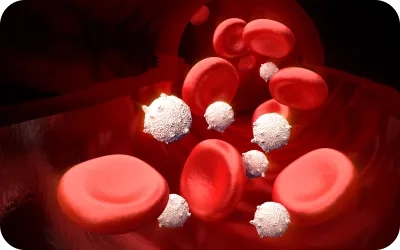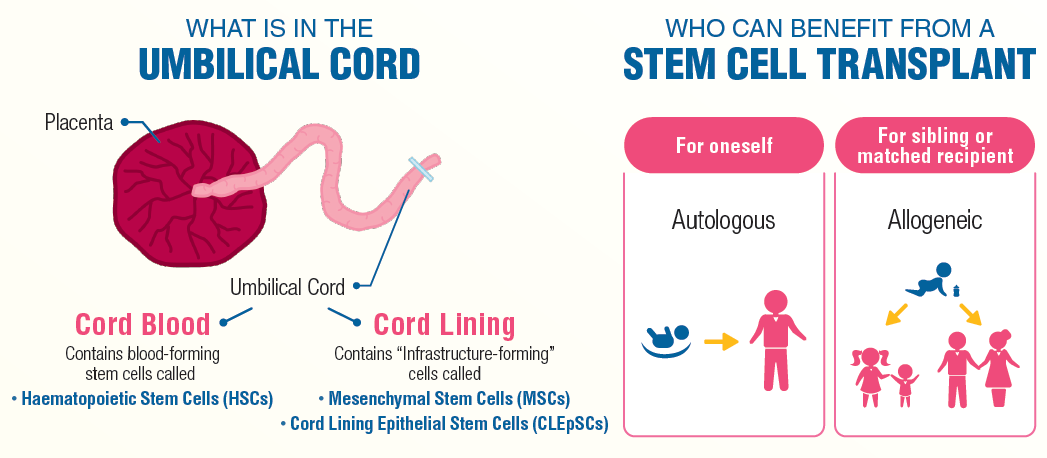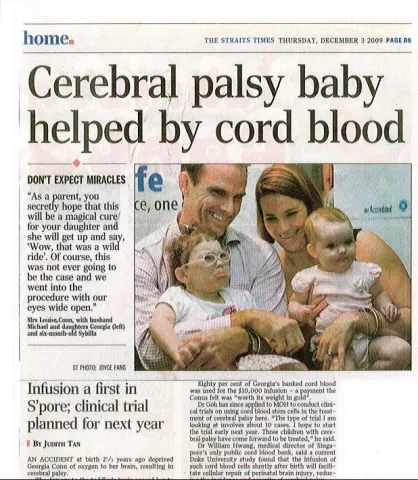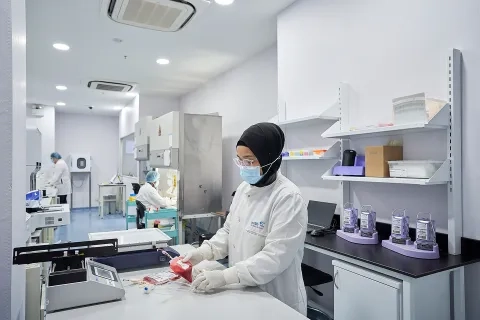Busting Myths: The Truth About Cord Blood Banking

With the impending arrival of a newborn, there are many important decisions that expectant parents have to make - one of which is whether to store their baby's umbilical cord stem cells.
We have put together a comprehensive guide to help you understand the benefits, processes, and considerations of umbilical cord banking so you can make an informed choice for your family's future.
What is Cord Blood?

Cord blood, also known as “placental blood”, is the blood that remains in the umbilical cord and placenta after birth. It is a rich source of Haematopoietic Stem Cells (HSCs), which play a crucial role in replenishing blood and regenerating the immune system. With the potential to treat over 80 diseases^ - including leukaemia, solid tumours, metabolic disorders, and immune conditions - cord blood is a valuable medical asset that deserves consideration.
Why Store Your Baby's Cord Blood?

In recent years, umbilical cord banking has become an essential part of birth planning, as there is only a once-in-a-lifetime chance to collect your baby's cord blood: minutes after birth.
Choosing to store your baby's cord blood is a form of biological insurance for your entire family, as the guarantees readily-available and exclusive medical resources for your family in the years to come and offers you a peace of mind with just one decision.
An increasing number of parents are also choosing to store their baby's cord lining. Cord lining is a sheet-like membrane from the umbilical cord that contains a high concentration of 2 types of stem cells, namely Mesenchymal Stem Cells (MSCs) & Cord Lining Epithelial Stem Cells (CLEpSCs). These regenerative stem cells are harvested and extracted using a patented CellOptima™ technology. They are the 'muscle-forming' & 'skin-forming' building blocks in the human body which have shown great potential in aiding the repair of injured tissues & organs.

Additionally, cord lining stem cells have immune-modulating capabilities, which means that they require less stringent matching between donor and recipient. This makes them not only suitable for your baby, but for other members of the family as well.
By storing a combination of HSCs, MSCs, and CLEpSCs, you are availing your children and family to be part of a medical revolution with access to the growing applications of stem cells and the therapeutic potential they hold.
Debunking Myths About Cord Blood Banking
Here are some of the most common questions and myths surrounding cord blood banking and how we have debunked them!
Myth 1: If a child gets sick, they cannot use their own cord blood
Fact: The ability to use one's own cord blood depends on the type of illness and when it is diagnosed. Autologous stem cell transplants - where the donor and recipient are the same person - can be used to treat certain non-genetic diseases and cancers without the risk of rejection. Additionally, a person can use his or her own cord blood stem cells to help restore bone marrow after chemotherapy for non-blood cancers.

Whether a child's cord blood can be used to treat himself/herself depends on the type of condition diagnosed and the age at which the diagnosis is made. If the condition is caused by environmental factors, the child can receive his/her own cord blood. For example, cancer has been shown in studies to be caused by genetics in only about 5% to 10% of the cases while environmental factors account for the remaining cases1. Patients with neuroblastoma can be treated with their own cord blood.
However, if the condition is genetic, it is not recommended that the child receive his/her own cord blood. In such cases, a sibling's stored cord blood may be a more viable option that opens up more medical treatment options. Based on Cordlife's data on cord blood units released for transplants over the years, 66%2 of cord blood units released for transplants were used for autologous treatments, demonstrating its valuable role in healthcare.
Myth 2: A bone marrow donor can always be found, so storing cord blood is unnecessary.
Fact: While bone marrow is a common source of stem cells, finding a perfect match is not always easy or quick. Cord blood stem cells, on the other hand, are more adaptable and can differentiate into various cell types. Having a stored supply of your baby's stem cells guarantees an exact match if needed, hence eliminating the challenges of a donor search that can be costly and time-consuming during a time-critical situation.
Cord blood also lowers the risk of Graft vs. Host Disease in autologous transplants, a situation where the transplanted tissue attacks the patient's own tissue. Unlike bone marrow extraction, which is an invasive procedure, cord blood collection is a simple, painless, and completely safe for both mother and baby.
Myth 3: Cord blood banking only makes sense if there is a family history of blood diseases.
Fact: Cord blood stem cells have applications far beyond blood disorders. They have the potential to treat leukaemia, lymphoma, and thalassemia, as well as metabolic and immune disorders. Furthermore, ongoing clinical trials are investigating its use in treating Autism Spectrum Disorder, Celebral Palsy, Type 1 Diabetes, Alzhemer's disease, spinal cord injuries and more3.

In Singapore, KK Women's and Children's Hospital (KKH) is currently conducting a clinical trial for the treatment of autism using the child's own blood stem cells that are stored with a family cord blood bank. as medical research continues to advance, the applications of cord blood banking are expanding, providing new hope for families worldwide.
Additionally, cord blood is not just for disease treatment - it can also help to restore bone marrow after chemotherapy4. By storing your baby's cord blood, you are securing access to a potentially life-saving resource for years to come.
Our Commitment to Quality and Security

At Cordlife, we are dedicated to ensuring the highest standards of security and reliability.
Enhanced Security Through Rigorous Checks
Our laboratory operates 365 days a year, following strict protocols to protect your child's cord blood. We perform thorough checks multiple times a day and closely monitor conditions to maintain optimal storage at all times.
Fortified Failsafe Measures
We have strengthened failsafe measures to ensure uninterrupted protection. Systems are fortified with multiple layers of redundancy, ensuring your child's cord blood remains secure even in the face of unexpected challenges.
Newly Enhanced Lab Monitoring System
Our advanced lab monitoring system offers 24/7 real-time on-site and remote surveillance. It includes proactive alerts and built-in redundancies, as well as a three-tiered escalation protocol to ensure swift action when needed.
More Experienced Lab & Technical Personnel
We have brought on board experienced professionals who bring a wealth of experience to every aspect of our operations, from routine checks and cord blood processing to handling critical inventions.
Backed by Experts for Quality
We maintain rigorous quality standards in all aspect of operations, guided by a Medical and Technical Advisory Board, which includes leading industry leading experts
Extensive Training for Cordlife's Lab Team
We have enhanced our laboratory team's expertise through comprehensive training programmes, ensuring they possess the knowledge and skills necessary to uphold their stringent protocols
Final Thoughts: A Simply Choice for a Healthier Future
Choosing to bank your baby's cord blood is more than a medical decision - it's an investment in your family's health and future. By making this choice today, you are securing access to an invaluable medical resource that could one day provide healing and hope.
At Cordlife, we are committed to offering the highest quality service to protect what matters most - your family's health and well-being.
References
^ For the full list of treatable diseases and references, please refer to https://www.cordlife.com/sg/treatable-diseases.
1Anand P, Kunnumakkara AB, Sundaram C, et al. Cancer is a preventable disease that requires major lifestyle changes. Phorm Res. 2008;25(9):2097-2116. doi:10.1007/s11095-008-9661-9.
2Based on Cordlife's cord blood release track record as of August 2024
3Diseases that can be Treated with Cord Blood page. Parent's Guide to Cord Blood Foundation website. https://parentsguidecordblood.org/en/diseases. Accessed March 27, 2025..
4Stem Cell Transplantation page. The Leukaemia & Lymphoma Society website. https://www.lls.org/leukemia/acute-lymphoblastic-leukemia/treatment/stem-cell-transplantation. Accessed March 27, 2025..
Recent Blog Posts
- 28 Mar 2025
- 10 Nov 2023
- 19 Oct 2022
- 19 Oct 2022
- 19 Oct 2022
